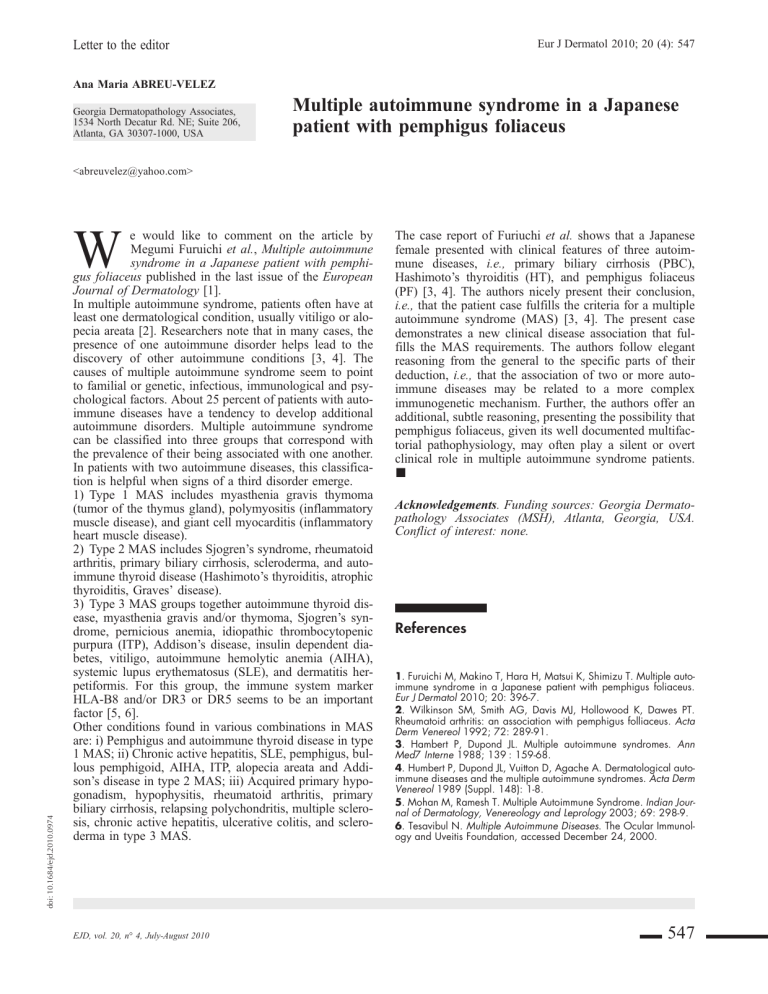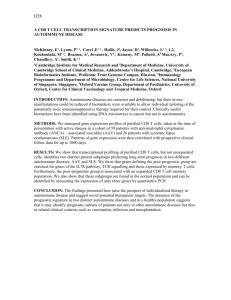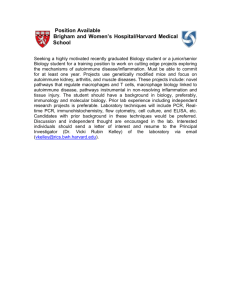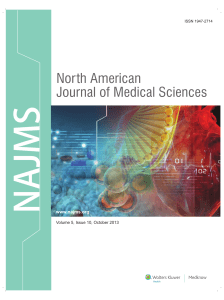Multiple autoimmune diseas the japanese
advertisement

Letter to the editor Eur J Dermatol 2010; 20 (4): 547 Ana Maria ABREU-VELEZ Georgia Dermatopathology Associates, 1534 North Decatur Rd. NE; Suite 206, Atlanta, GA 30307-1000, USA Multiple autoimmune syndrome in a Japanese patient with pemphigus foliaceus <abreuvelez@yahoo.com> doi: 10.1684/ejd.2010.0974 W e would like to comment on the article by Megumi Furuichi et al., Multiple autoimmune syndrome in a Japanese patient with pemphigus foliaceus published in the last issue of the European Journal of Dermatology [1]. In multiple autoimmune syndrome, patients often have at least one dermatological condition, usually vitiligo or alopecia areata [2]. Researchers note that in many cases, the presence of one autoimmune disorder helps lead to the discovery of other autoimmune conditions [3, 4]. The causes of multiple autoimmune syndrome seem to point to familial or genetic, infectious, immunological and psychological factors. About 25 percent of patients with autoimmune diseases have a tendency to develop additional autoimmune disorders. Multiple autoimmune syndrome can be classified into three groups that correspond with the prevalence of their being associated with one another. In patients with two autoimmune diseases, this classification is helpful when signs of a third disorder emerge. 1) Type 1 MAS includes myasthenia gravis thymoma (tumor of the thymus gland), polymyositis (inflammatory muscle disease), and giant cell myocarditis (inflammatory heart muscle disease). 2) Type 2 MAS includes Sjogren’s syndrome, rheumatoid arthritis, primary biliary cirrhosis, scleroderma, and autoimmune thyroid disease (Hashimoto’s thyroiditis, atrophic thyroiditis, Graves’ disease). 3) Type 3 MAS groups together autoimmune thyroid disease, myasthenia gravis and/or thymoma, Sjogren’s syndrome, pernicious anemia, idiopathic thrombocytopenic purpura (ITP), Addison’s disease, insulin dependent diabetes, vitiligo, autoimmune hemolytic anemia (AIHA), systemic lupus erythematosus (SLE), and dermatitis herpetiformis. For this group, the immune system marker HLA-B8 and/or DR3 or DR5 seems to be an important factor [5, 6]. Other conditions found in various combinations in MAS are: i) Pemphigus and autoimmune thyroid disease in type 1 MAS; ii) Chronic active hepatitis, SLE, pemphigus, bullous pemphigoid, AIHA, ITP, alopecia areata and Addison’s disease in type 2 MAS; iii) Acquired primary hypogonadism, hypophysitis, rheumatoid arthritis, primary biliary cirrhosis, relapsing polychondritis, multiple sclerosis, chronic active hepatitis, ulcerative colitis, and scleroderma in type 3 MAS. EJD, vol. 20, n° 4, July-August 2010 The case report of Furiuchi et al. shows that a Japanese female presented with clinical features of three autoimmune diseases, i.e., primary biliary cirrhosis (PBC), Hashimoto’s thyroiditis (HT), and pemphigus foliaceus (PF) [3, 4]. The authors nicely present their conclusion, i.e., that the patient case fulfills the criteria for a multiple autoimmune syndrome (MAS) [3, 4]. The present case demonstrates a new clinical disease association that fulfills the MAS requirements. The authors follow elegant reasoning from the general to the specific parts of their deduction, i.e., that the association of two or more autoimmune diseases may be related to a more complex immunogenetic mechanism. Further, the authors offer an additional, subtle reasoning, presenting the possibility that pemphigus foliaceus, given its well documented multifactorial pathophysiology, may often play a silent or overt clinical role in multiple autoimmune syndrome patients. ■ Acknowledgements. Funding sources: Georgia Dermatopathology Associates (MSH), Atlanta, Georgia, USA. Conflict of interest: none. References 1. Furuichi M, Makino T, Hara H, Matsui K, Shimizu T. Multiple autoimmune syndrome in a Japanese patient with pemphigus foliaceus. Eur J Dermatol 2010; 20: 396-7. 2. Wilkinson SM, Smith AG, Davis MJ, Hollowood K, Dawes PT. Rheumatoid arthritis: an association with pemphigus folliaceus. Acta Derm Venereol 1992; 72: 289-91. 3. Hambert P, Dupond JL. Multiple autoimmune syndromes. Ann Med7 Interne 1988; 139 : 159-68. 4. Humbert P, Dupond JL, Vuitton D, Agache A. Dermatological autoimmune diseases and the multiple autoimmune syndromes. Acta Derm Venereol 1989 (Suppl. 148): 1-8. 5. Mohan M, Ramesh T. Multiple Autoimmune Syndrome. Indian Journal of Dermatology, Venereology and Leprology 2003; 69: 298-9. 6. Tesavibul N. Multiple Autoimmune Diseases. The Ocular Immunology and Uveitis Foundation, accessed December 24, 2000. 547






